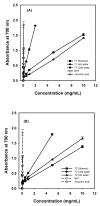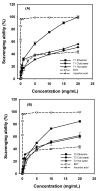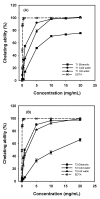Antioxidant properties and antioxidant compounds of various extracts from the edible basidiomycete Grifola frondosa (Maitake)
- PMID: 21499220
- PMCID: PMC6260640
- DOI: 10.3390/molecules16043197
Antioxidant properties and antioxidant compounds of various extracts from the edible basidiomycete Grifola frondosa (Maitake)
Abstract
Grifola frondosa is an edible mushroom currently available in Taiwan. Ethanolic, cold-water and hot-water extracts were prepared and their antioxidant properties were investigated. At 1 mg/mL, G. frondosa T1 and T2 cold-water extracts showed high reducing powers of 1.02 and 0.50, respectively. Chelating abilities on ferrous ions of G. frondosa T1 and T2 were higher for cold-water extracts than for ethanolic and hot-water extracts. For the scavenging ability on 1,1-diphenyl-2-picrylhydrazyl (DPPH) radical, G. frondosa T1 and T2 extracts were effective in the following order: ethanolic > hot-water > cold-water. The G. frondosa hot-water extract showed high scavenging ability on superoxide anions. Total phenols, flavonoids, ascorbic acid and α-tocopherol are the major antioxidant components found in the various G. frondosa extracts. Based on EC(50) values (<20 mg/mL) obtained, the various extracts from G. frondosa investigated in this study display potent antioxidative properties.
Figures




References
-
- Wang Z., Luo D. Antioxidant activities of different fractions of polysaccharide purified from Gynostemma pentaphyllum Makino. Carbohydr. Polym. 2007;68:54–58. doi: 10.1016/j.carbpol.2006.07.022. - DOI
-
- Mayell M. Maitake extracts and their therapeutic potential. Altern. Med. Rev. 2001;6:48–60. - PubMed
-
- Masuda Y., Matsumoto A., Toida T., Oikawa T., Ito K., Nnaba H. Characterization and antitumor effect of a novel Polysaccharide from Grifola frondosa. J. Agric. Food Chem. 2009;57:10143–10149. - PubMed
Publication types
MeSH terms
Substances
LinkOut - more resources
Full Text Sources
Medical

